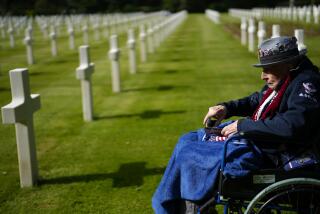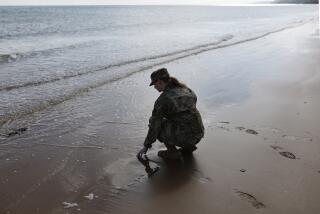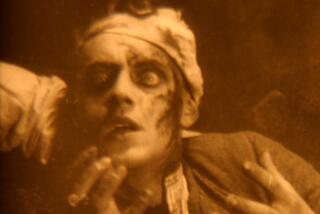Destination: France : Grounds for Reflection : In a year of V-E Day festivities, Verdun still recalls pain and bloodshed of World War I
VERDUN, France â It was summer, and picnickers sprawled in the high grass by the side of Route Departmentale 112, enjoying their baguettes stuffed with cheese and the long days filled with warm sunshine.
Grain, high and green, trembled in the tranquil fields of the Meuse heights as the breeze swept over it. Black-and-white dappled cows grazed in their pastures.
The scene was serene and beautiful, the epitome of the prosperity of rural France. Yet for 10 months in 1916, as an estimated 60 million artillery shells tore through the air and millions of men fought desperately over this very ground, this stretch of quiet northeastern French countryside was a hell on Earth.
A few more years, and Verdun and the other great campaigns of the First World War--âthe Great Warâ that began 80 years ago last August--will cease to be a part of living peopleâs experience and slip into ancient history.
Already upstaged by last yearâs 50th-anniversary D-day celebrations and this Mayâs V-E Day hoopla, the titanic and often senseless slaughter on the Somme River, the fields of Flanders and even at places such as Saint-Mihiel south of Verdun, where Americans fought and died, seem no more familiar to most of us than Thermopylae or Waterloo--perhaps even less so.
Yet at Verdun, from Feb. 21 until Dec. 15, 1916, no fewer than 700,000 soldiers, French and German, were killed or wounded, one by one, in a veritable orgy of butchery involving artillery shells, trench mortar bombs, rockets, machine guns, rifles, poison gas, flame throwers, bayonets and hand-to-hand fighting.
Only seven aged and frail veterans, men who could rummage in their memories and recall what it was like, managed to make it back for the anniversary of the beginning of the battle last year. Hobbled these days by gout, but able to evoke those momentous days with the vividness of newsreel film, Rene Vincent, 98, was one of them. His keen blue eyes still leak tears as he remembers.
âIt was cafard [the blues], despair, that we suffered from, not fear,â said the former sergeant in the French chasseurs, or light infantry, who was wounded or gassed five times during World War I and was decorated with the coveted Legion of Honor. âWe just didnât see the end of it.â
No fewer than six times, Vincent was rotated in and out of the trenches at Verdun. Under the oats, wheat and barley and apple and plum trees that now grow in the northwestern corner of the old French duchy of Lorraine, the remains of tens of thousands of his contemporaries lie pulverized and churned into the very soil they fought to possess.
Across half a million acres plowed and re-plowed by shells, the earth itself has been maimed. It rises and falls in places like the storm-whipped sea or is cratered like the moon. In spots, the vegetation hasnât grown back or is weirdly stunted despite decades of efforts to make something grow.
Nine ghost villages, pounded into dust by the cannon and howitzers, are marked by pathetic signs that say: Mort Pour la France (Died for France).
For France, victory in this great battle marked a turning point. Yet historians theorize that the carnage here was so stupendous, the killing so wanton, that it traumatized the French army and nation into general inaction when they were faced in 1940 with the onslaught of Hitlerâs Wehrmacht.
Militarily, France also drew the wrong lessons. A World War I veteran from Lorraine later became war minister of France, and set out to build a chain of fortifications that, unlike Verdunâs, could not be breached. His name was Andre Maginot and his brainchild the ill-fated Maginot Line.
*
By a strange twist of history, Verdun has also come to have a link to the America of our era. As a military brat growing up on U.S. bases in Western Europe, Newt Gingrich visited Verdun and was shocked by the mountains of bones he saw here.
The young Gingrich had wanted to be a zookeeper, but Verdunâs mingled testimony to common soldiersâ valor and the tragedy of their commandersâ obstinate willingness to throw away hundreds of thousands of lives, changed his mind and pushed him irrevocably toward politics. In a sense, the career of the Speaker of the House of Representatives and the Republican Partyâs âContract With Americaâ had its genesis in these green and blood-soaked hills 160 miles east of Paris.
My French-born wife, Yvonne, and I decided to visit with our two daughters while there were still people alive who could tell us what the battle had been like. In retrospect, it was the most absorbing stop during a week we spent in eastern France, one that ranged from Nancy and its stunning 18th-Century Place Stanislas to the cool pine forests of the Vosges.
One warm afternoon last July, we checked into the family-owned Sirene Hotel in Etain, 12 miles east of Verdun. It had a new tennis court but was slightly shabby and roamed by an ancient and slobbering spaniel.
We probably would have done better to reserve a room in Verdun itself. Home to 20,000 people, it is a pleasant provincial town bisected by the slow-moving Meuse. It was the target of German bombardments during the war, but was never taken, and boasts some charming old monuments such as the turreted 14th-Century Porte Chaussee Gate, a masterpiece of medieval military architecture.
Thanks to the helpful young women who staff Verdunâs tourism office on the Place de la Nation, we arranged for a guide, bought a slab of tickets to see the most important sites and museums, and even arranged an afternoon visit to the hospitable Monsieur Vincent.
âThe number of people who died, it was incroyable [incredible],â said our host, who can see many of the battle sites from his geranium-bedecked villa on the Rue du Briolet. âIt was a battle of heavy artillery, really.â
The targets were men such as Vincent, whose sole protection was their steel helmets and trenches less than five feet deep.
Every year, half a million tourists, mostly French, but many Germans as well, come to gaze on these quiet woods and fields. By viewing the ruins of fortifications and the scars the earth still bears, and visiting informative and moving exhibits, one gets an idea--very feeble and sanitized, no doubt--of what one of historyâs greatest battles must have been like.
For instance, there is the Fort de Vaux. Our 22-year-old daughter Cecile proclaims to everyone that she is bored by history, but the story of the subterranean fortificationâs heroic defenders brought tears to her eyes as guide Francoise Level showed us through its chilly corridors where dripping water is now forming stalactites.
For six days and nights, a 250-man detachment led by Commandant Raynal, an officer from Bordeaux with a bum leg, held out here against an overwhelmingly superior German attack. Day after awful day, in darkened underground passages cluttered with dead and the screaming wounded, the battle raged in the fortâs very heart.
Close your eyes, ignore the passing tourists or the souvenir stand at the entrance selling postcards and World War I memorabilia and itâs all too easy to imagine.
For something like 144 straight hours, there would have been the deafening detonations of shells and grenades, the billowing flames from the Germansâ flamethrowers (a weapon some historians say made its debut at Verdun), palls of poison gas and smoke and the smells and sounds of scores of trapped and desperate men.
In a fruitless attempt to be disengaged, Raynal sent off his last carrier pigeon with a plea for help. Its fate electrified Cecileâs sister Charlotte, 10. The bird got through to French lines, but had inhaled so much gas and smoke on the way that it died immediately. It was posthumously awarded a medal.
Driven half-mad by thirst, the survivors among Raynalâs men licked Vauxâs walls for moisture and drank their urine before they finally surrendered.
A 10-minute drive to the west, at what is perhaps the most bizarre monument in all of France, the scale of the killing at Verdun becomes clear. In the 18 crypts of the Ossuary of Douaumont, a building capped by a 150-foot tower shaped like an artillery shell, the bones of 130,000 soldiers, German as well as French, now lie together in ivory mounds.
This white-stone monument, inaugurated in 1932, may be the worldâs largest charnel house. Peek though the ground-level windows, as we and the young Newt Gingrich did, and you can see the jumbled stacks of ribs, femurs and tibiae that are the mingled remains of Verdunâs assailants and defenders, and of others who died in the region during fighting before and after the great battle. On the lawn in front of the Ossuary, 15,000 French soldiers whose remains could be identified have been buried in individual plots.
In an underground movie theater at the Ossuary, an excellent 20-minute film tries to make sense out of what Verdun was like for the ordinary Frenchman who lived and died in the trenches. These men, peasants from Brittany or workers from the Paris faubourgs (suburbs), became known as the poilus (hairy ones) since they didnât or couldnât shave or cut their hair at the front.
âItâs the poilu who won the war,â declared General Henri Philippe Petain, who fatefully for France as it turned out, was put in charge of the defense of Verdun. For, 22 years after the end of World War I, when they had been overwhelmed by the Nazi blitzkrieg of 1940, the French again would turn to the âhero of Verdunâ to lead them--this time into the disgraceful collaboration of Vichy.
Soldiers at Verdun lived in shell holes and drank muddy water from the same stinking puddles where their dead comrades lay festering. They lugged equipment weighing 75 pounds and more through machine-gun fire, salvos of artillery and mortar shells weighing up to one ton and gas attacks. They died en masse to carry out Petainâs famous order: âThey shall not pass!â
There was no rest for even the dead, Vincent remembers. Bodies would be disinterred by enemy shellfire from the makeshift cemeteries where they had been hastily buried, and bones and flesh catapulted into the air.
German soldiers endured the same terrible conditions and perished here in only slightly lesser numbers. Now distant enough in time and unconfused by the racist Nazi philosophy or atrocities, Verdun has become a site and symbol of Franco-German reconciliation and has given itself the title âcapital of peace.â
At the Memorial-Museum of the Battle of Verdun, midway between Fort de Vaux and the Ossuary, a series of splendid exhibits and two films bring alive Verdun and the First World War in general. Showcases feature uniforms and weapons (including the long-barreled, mediocre French Lebel rifle) and depict numerous themes, such as how Petainâs men built and operated âthe Sacred Way,â Verdunâs single road link with the rear.
Thanks to poilusâ recollections, a segment of the battlefield has been reconstructed, littered by barbed wire, dead menâs equipment and muck-filled shell holes. The ravenous rats, putrefying corpses, cold, hunger, thirst, disease and flies are left to a visitorâs imagination.
In Verdun itself, inside the labyrinthine Underground Citadel that served as a command post, garrison and rest area for the poilus, a unique ride provides an idea of what it was like in the trenches. You take a blanket, because the temperature is in the mid-40s, and climb into an automatically guided cart. For 25 minutes, the cart trundles by holographic tableaux that evoke life in wartime Verdun and the Citadel.
Then, to the chatter of machine guns and the thunder of artillery that you can feel in your feet, you sweep through a trench as a regiment of blue-uniformed poilus prepare to go âover the top.â Some look resigned, others jumpy. A few salute you as Mon Capitaine .
At Verdun, the French emerged victorious because of the bravery and dedication of the common soldier, but also because an Anglo-French offensive on the Somme in the summer of 1916 forced the Germans to order their units here onto the âstrict defensive.â By December, at great cost, the French had virtually recaptured all of the lost land and fortifications.
By 1918, 2 million U.S. doughboys had arrived in France, and many took part in fighting at Saint-Mihiel and other battles near Verdun. Stories of what the poilu endured here deeply impressed them.
So much so that American donors paid for the Ossuaryâs tower. A U.S. philanthropist also financed a monument to a celebrated, but, it appears, apocryphal incident: the supposed burying alive of an infantry regiment when its trench collapsed during a barrage. Today as then, only the bayonets protrude above ground.
Now most military historians believe the trench was captured by the Germans, filled with corpses and covered over as a common grave. But the legend continues to epitomize the helplessness of the common soldier at Verdun.
Vincent has had many decades to reflect on the events he took part in. He proudly shows his many medals, but calls war âthe shame of humanity, a horror that shouldnât exist.â Let those who disagree visit Verdun.
(BEGIN TEXT OF INFOBOX / INFOGRAPHIC)
GUIDEBOOK
Verdun at Peace
Getting there: Fly nonstop LAX to Paris on United and Air France; direct on American, USAir and Continental; connecting service on most international carriers. Fares start at about $1,075 round trip including taxes and fees. From Paris to Verdun, there are several trains a day, requiring one change; $54 one way, first class; $37 second class for the three-hour trip.
Where to stay: The three-star Hostellerie du Coq Hardi (8 Avenue de la Victoire, 55100 Verdun; telephone 011-33-29-86-3636, fax 011-33-29-860921) is where French generals reportedly stayed during the battle; 33 rooms, excellent restaurant; single/double rates $70-$140. The two-star Hotel Orchidees (55100 Verdun; tel. 011-33-29-864646, fax 011-33-29-861020) has 43 rooms, restaurant, single/double rates $55-$70. The two-star Hotel Montaulbain (4 Rue Vieille-Prison, tel. 011-33-29-860047) has only 10 rooms; single/double rates $28-$45. The three-star Hostellerie du Chatea^u des Monthairons, in the town of Monthairons, eight miles from Verdun (55320 Monthairons; tel. 011-33-29-877855, fax 011-33-29-877349) is a 19th-Century chateau set in a park; nine rooms, restaurant; rates $100-$165.
For more information: French Government Tourist Office, 9454 Wilshire Blvd., Suite 715, Beverly Hills 90212; tel. (900) 990-0040 (calls cost 50 cents per minute; call before 2 p.m.), fax (310) 276-2835. Or call the tourist office in Verdun, tel. 011-33-29-861418, fax 011-33-29-842242.
More to Read
Sign up for The Wild
Weâll help you find the best places to hike, bike and run, as well as the perfect silent spots for meditation and yoga.
You may occasionally receive promotional content from the Los Angeles Times.






